| Hans Christian Andersen and Music | Agnete's Lullaby |
|
Agnete and the Merman was one of the poems for which Andersen had tremendously high expectations, and these in no way diminished when he reworked it for the stage. The poem is also an example of the utilization of old Danish folk ballads to symbolize Danish identity that was common practice during the first half of the nineteenth century . The ballad about Agnete and the merman in particular was elaborated on by several writers, including Johannes Ewald, Jens Baggesen, Adam Oehlenschläger and Johan Ludvig Heiberg. At the same time the legend presents supernatural creatures such as a merman and mermaids, which were also popular and mystical in the romantic world. In particular, Agnete’s beautiful lullaby in Andersen’s version has appealed to many composers.
The text
In August he was able to send part of the poem back to Edvard Collin with the actor Gottlob Stage and at the same time he asked Collin to send a copy “of the old ballad about Agnete”, not Baggesen’s or Oehlenschläger’s adaptations. At the same time, Andersen could hardly wait to hear Collin’s reaction to the opening scenes. Collin replied towards the end of August, saying that the poem was too trivial and in too many ways reminiscent of the Aladdin story. Finally he criticized Andersen for not having an objective approach to his story, but had put too much of himself into it. However, Andersen’s replied that the second part of the play would probably rectify these shortcomings, and that he did not wish to make any changes in the first part. Around 1st September 1833 Andersen reached the little clock-making town of Le Locle in the Jura mountains, and here he finished writing Agnete and the Merman. On 2nd September he wrote to his friend Henriette Wulff: “Now she is lying still, dozing a little, and will perhaps have another beautiful dream of some kind that she can relate, and then I can adorn a bit, give her a little grammar (for that’s something they take very seriously at home)”. On 11th September Andersen was finally able to send “my Agnete quite finished...” and in his letter to Edvard Collin he continued: “...receive her kindly, the dear child, born amongst mountains, but Danish at heart”. And again he found it hard to wait for Collin’s opinion of the whole poem and also to get it printed, for he was badly in need of the money. To Andersen, Agnete and the Merman was a picture of “the never satisfied longing of the heart, its wondrous yearning for a new, different way of being”, and thus the poem meant a great deal to him. He regarded it as one of his best works, which “would close the mouths of many people”. It was therefore particularly distressing when Edvard Collin sent a reply on 18th December 1833 in which he expressed scathing criticism of the poem, adding that Andersen wrote far too much and too childishly – especially with regard to the character Hemming, and that parts of Agnete were “desperately misshapen, virtually without form”. He quoted the author Just Mathias Thiele as having said that the poem had been “hastily pasted together”. Andersen was deeply upset by this and wrote “the letter drove me to despair". Edvard’s father, Jonas Collin, had to write a soothing letter accounting for the heated tones of both men. In a letter to Ingemann, Andersen recalled the discussion: “Here [in the Jura Mountains] I completed my Agnete in quiet isolation, a work that became strangely dear to me, and which at the time I was unspeakably happy about. No outsider’s hand then slashed her limbs to see whether she had been created with sufficient artistry.” On several occasions Andersen read Agnete and the Merman aloud to his hosts and friends – he was very clearly interested in hearing reactions to this, his most cherished work. At the end of October 1833 he thus read it to Princess Charlotte Frederikke (the divorced wife, then living in Rome, of Prince Christian, later Christian VIII) and on this occasion Bertel Thorvaldsen was also present. In December 1833 he repeated his recital – also in Rome, when both Thorvaldsen and Henrik Hertz were among his listeners. The sculptor remarked afterwards that the piece was “from the woods and lakes at home”, which particularly pleased Andersen. B.S. Ingemann also expressed his approval and called the poem “a Nordic romantic summer night’s dream”. By the middle of 1833 Collin had already thought of approaching the Danish publishers Reitzels Forlag to get Agnete and the Merman published, but although Andersen had had many ideas as to how it should be printed, this publishing house was not prepared to pay the fee requested. Collin decided to try to find subscribers to have the work published by "Forfatterens Forlag" (published by the author), for which Andersen was very grateful. The work was published on 23rd December 1833, but with the year 1834 on the title page, and it was dedicated to the director of the Foundation ad usus publicos, the titular prime minister J.S. Møsting – this foundation had financed Andersen’s journey. Despite the poem’s cool reception in 1834, Andersen started work on Agnete and the Merman again in May 1842, probably at the instigation of the actor Wilhelm Holst, who needed a play for a summer performance. The revision consisted in adaptating the text from being an epic-cum-lyrical poem to a dramatic work – a task which Andersen completed in the course of only five days. But it did not result in a performance that summer, for it was not until 2nd September 1842 that Andersen and the composer Niels W. Gade sent their work to the Royal Theatre in Copenhagen. Christian Molbech’s comment on the work is typical of the period: “Seeing that everything, especially here in Denmark, has to be dramatized and put on the stage, be it dramatic material or not, and now that long, epic poems, novels and short stories must share this fate with romances and ballads, why not for once also translate the poem about Agnete at Holmegaard into a form of dialogue? When good music and decorations are added, this sort of thing usually creates some kind of effect.” The play was accepted on 16th September 1842, but the première at the Royal Theatre was not until 20th April the following year. However, it only ran for two performances, even with the celebrated actress Johanne Louise Heiberg in the title role and the barytone Christian Hansen as her earthly fiancé, Hemming. The actor Wilhelm Holst played the Merman – without songs. Andersen was away travelling at the time and happened to be in Paris, so Edvard Collin had to tell him, in a letter about the reception, that, amongst other things, he had “expected every moment to hear laughter from the only-too-willing plebs.” However, Collin had to admit that “on the second night the play did actually improve a little...” The Copenhagen daily Berlingske Tidende wrote simply that “there were some hisses amongst the applause”, while Johan Ludvig Heiberg declared “it goes without saying that the situation has not been improved, in fact on the contrary, by the direct transfer of an extract from the poem from the bookshop to the stage”. A later (1864) rather negative view was expressed by the theatre historian Thomas Overskou to the effect that the play, “due as much to the lack of action and characters as to the inability to provide a satisfying theatrical work, became so tedious that even Gade’s poetic music and generally good performances on the part of the actors, proved insufficient to avert distaste”. So in a letter to Edvard Collin in November 1843, Andersen finally conceded that “Agnete has been shelved forever”. Niels W. Gade
A year later he had greater plans for the legend. It was to form the basis of a symphony in five movements with a choir. However, only a sketch of the general idea has been preserved in Gade’s so-called little ‘composer’s diary’. In this, Gade had obviously let himself be inspired by Andersen’s dramatic poem from 1833–34, but aspects of the writer Jens Baggesen’s long epos Agnete fra Holmegaard (1808) are represented. This plan, however, was never realized either. It is uncertain how Gade’s and Andersen’s collaboration on Agnete and the Merman was initiated, but correspondence indicates that Gade had written the music early in the summer of 1842. In July Andersen asked him to write an overture, but nothing came of it. On the other hand Gade wrote the music for eight songs, some for a choir, in which each person is characterized by particular combinations of instruments. The piece thus glides into the ballad opera tradition with a mixture of song and spoken dialogue. In his report to Andersen about the work’s reception, Collin was thus able to conclude that “the music was delightful and left nothing to be desired”. Johan Ludvig Heiberg added in his review that it would have been better if “Mr Gade had not squandered his characteristic, emotional music on a work concerning which it was so easy to foresee that it would be unable to support it”. Berlingske Tidende stressed in particular that “The lullaby which Mrs Heiberg sang so expressively was extremely moving”. [ In 1845 Gade reworked six of the songs with piano accompaniment for publication with the text in both Danish and German, the latter translated by N.C.L. Abrahams. Gade dedicated the songs to his teacher, the composer A.P. Berggreen, whose great interest happened to be folk ballads. [ Berggren collected and published a large number of these ballads and also formulated a kind of manifesto as to how composers should use them, namely that they should have “become inherent in the composer’s being, who then, filled with their spirit, would be able to give his work this singular, national stamp which above all imbues a work of art with meaning”. Gade utilized this in several of his compositions, especially in his well-known works the Ossian overture from 1840 and the later concert piece Elverskud (The Elf King’s Daughter) from 1854. [ In 1849 Gade reworked two of the songs, including Agnete’s Lullaby, for solo, female choir and orchestra, as a concert piece called Agnete og Havfruerne (Agnete and the Mermaids), which was performed at Gade’s own concert at the Court Theatre on 24th February 1849 with the Royal Orchestra and probably the Music Society’s female choir. It was a great success and an encore was called for, but this did not materialize. Agnete and the Mermaids was not included in the Music Society’s programmes until 1858 and was not published until the year after Gade’s death, in 1891. Peter Heise
However, Heise’s melody for Agnete’s Lullaby was not printed with Andersen’s text until 1858 in the collection 115 Melodier til ”Nye og gamle Viser af og for Danske Folk” (115 Melodies for new and old verses of and for Danish People), which was published by the priest and teacher P.O. Boisen and the composer Christian Bull – here the 2nd edition from 1858. Both the song book and the melody book were widely distributed and may be regarded as being among the precursors of the extremely popular Folkehøjskolens Melodibog (The Folk High School’s Melody Book). It was not until 1891 that Heise’s version of Agnete’s Lullaby appeared independently after having been published in Wilhelm Hansen’s music periodical Musik-Journalen earlier that year. [ Fini Henriques
The songs are dedicated to four girls’ names, the first of which is Fini Henriques’s wife, Johanne Elfriede, called Adda née Krogh, whom he married in July 1891. Agnete’s Lullaby bears the name Augusta Krogh, who was possibly related to Adda, while the other two songs are dedicated to Gerda Henriques (who might well be the composer’s newly born niece) and Hedvig (no further specification). Fini Henriques only uses verses 1, 3 and 4 of Andersen’s poem, but on the other hand he repeats the last line of each stanza as a conclusion to the song. He retains a decisively lullaby style with a rocking 12/8 rhythm, but the piquant use of harmony and to some extent the movement of the melody line is used by Henriques to emphasize the doubt and uncertainty expressed by Agnete in the poem. The song is moreover designated Flebile, which means sorrowful or pitiful. [ |
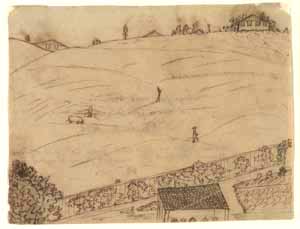 Under his drawing of the clockmaking town in the Jura mountains, where he finished writing Agnete and the Merman, Andersen wrote: “View from my window in Le Locle in the Jura Mountains, 5th September 1833.” The original is in Odense Bys Museer.
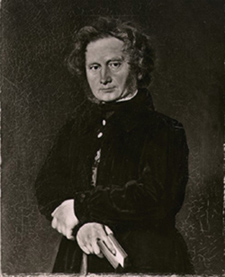 Unlike some of Andersen’s close friends, Ingemann’s reaction to Agnete and the Merman was positive.
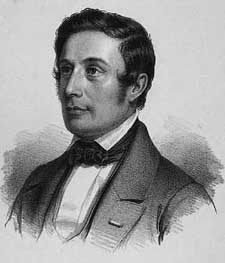 The actor Wilhelm Holst played the part of the Merman in the production at the Royal Theatre in Copenhagen, and it was probably at his instigation that Andersen reworked his poem as a dramatic work.
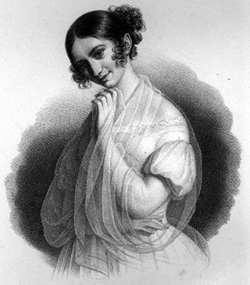 Johanne Louise Heiberg was highly praised for her performance as Agnete in the production at the Royal Theatre.
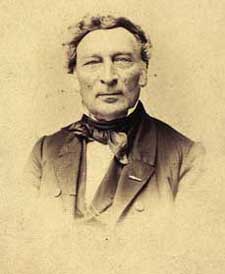 The composer A.P. Berggreen had both Gade and Heise as pupils. He inspired both composers to introduce folk ballad subjects into their compositions as an expression of Danish identity. He himself collected folk ballad melodies – also from abroad – which he published in a series of volumes of folk songs and melodies, Danish as well as from other countries.
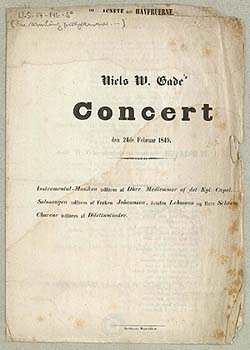 The programme of Gade’s own concert at the Court Theatre on 24th February 1849, where the revised version of Agnete’s Lullaby (amongst others) in the poem Agnete and the Merman was performed for the first time.
|
